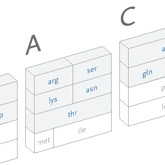
Genetics projects



A redesign of traditional diagrams of the genetic code to clarify and highlight patterns in the data. Includes an interactive version that depicts how the code works. (2001, updated 24 February 2008)
Combination of several different representations of haplotype data into a single interactive tool. (2001, updated February 2004)
A later adaptation of the Valence project that visualizes biological data, and was created for the 2002 Whitney Biennial. (March 2002, updated November 2003)
The biologist's calculator: a genome browser that runs on a handheld device. (2001)
Tools
Bifurcator, 2004
This tool creates a bifurcation plot suitable for publication from a set of haplotype data. Given a set of SNPs that define a "core" region, the program creates an image of how individual genotypes differentiate from that point.
Microarray Clustering with CAST, December 2000
Implementation of the CAST algorithm to cluster microarray data, developed for a class project
Illustrations
Sequences of human DNA aligned with about a dozen other mammals, created as an illustration for Seed Magazine.
Cover for the journal Nature, announcing the completion of the first phase of the HapMap project.
An illustration of how the gene FOXP2, believed to be connected to language acquisition, differs in humans versus chimps.
Large format (9 x 18 feet) print of all the known and predicted genes in the human genome
Installation depicting thirteen million letters (one quarter) of human chromosome 21, colored by their use
Poster depicting all the genes of chromosome 14 in the human genome
The A, C, G, and T letters of human chromosome 22 shown in a three pixel font
Papers
Clinical and laboratory predictors of Lassa fever outcome in a dedicated treatment facility in Nigeria: a retrospective, observational cohort study DOI: 10.1016/S1473-3099(18)30121-X
Clamp M, Fry B, Kamal M, Xie X, Cuff J, Lin MF, Kellis M, Lindblad-Toh K, Lander ES.
Distinguishing protein-coding and noncoding genes in the human genome.
Proc Natl Acad Sci U S A. 2007 Dec 4;104(49):19428-33. Epub 2007 Nov 26.
Pardis C. Sabeti*, Patrick Varilly*, Ben Fry, Jason Lohmueller, Elizabeth Hostetter, Chris Cotsapas, Xiaohui Xie, Elizabeth H. Byrne, Steven A. McCarroll, Rachelle Gaudet, Stephen F. Schaffner, Eric S. Lander & The International HapMap Consortium
Genome-wide detection and characterization of positive selection in human populations.
Nature. 2007 Oct 18; 449(7164):913-8.
Sabeti PC, Schaffner SF, Fry B, Lohmueller J, Varilly P, Shamovsky O, Palma A, Mikkelsen TS, Altshuler D, Lander ES.
Positive natural selection in the human lineage.
Science. 2006 Jun 16;312(5780):1614-20. Review.
Bernstein BE, Mikkelsen TS, Xie X, Kamal M, Huebert DJ, Cuff J, Fry B, Meissner A, Wernig M, Plath K, Jaenisch R, Wagschal A, Feil R, Schreiber SL, Lander ES.
A bivalent chromatin structure marks key developmental genes in embryonic stem cells.
Cell. 2006 Apr 21;125(2):315-26.
Walsh EC*, Sabeti P*, Hutcheson HB*, Fry B*, Schaffner SE et al.
Searching for signals of evolutionary selection in 168 genes related to immune function.
Hum Genetics, Jan 2006.
Sabeti PC, Walsh E, Schaffner SF, Varilly P, Fry B, et al.
The case for selection at CCR5-Delta32.
PLoS Biol 3(11): e378.
Yu F, Sabeti PC, Hardenbol P, Fu Q, Fry B, et al.
Positive selection of a pre-expansion CAG repeat of the human SCA2 gene.
PLoS Genet 1(3): e41.